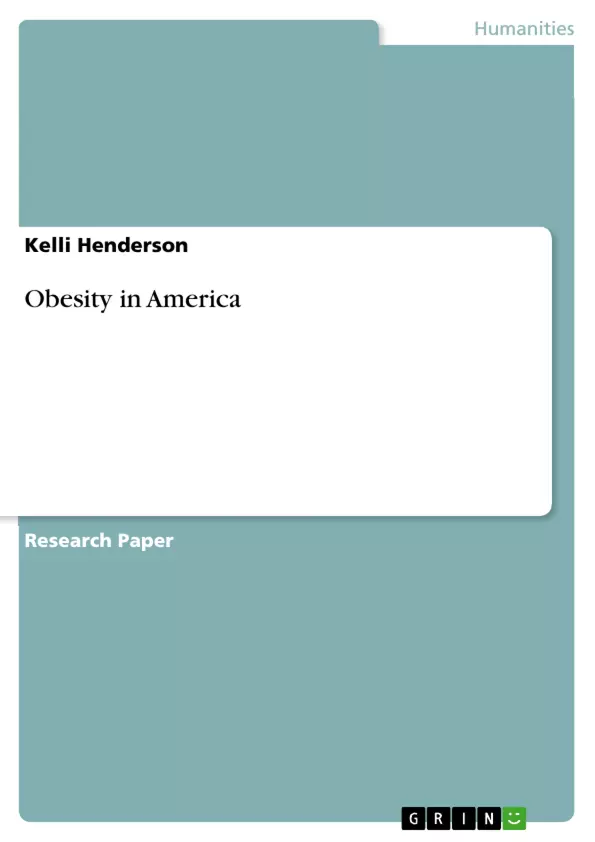Over the past few decades, obesity in America has become an epidemic. An individual is obese when their body mass index (BMI) reaches 30 of higher. When an individual is obese, health risks arise. These risks include cardiovascular disease, diabetes, high blood pressure, stroke, sleep apnea, gall bladder disease, respiratory disease, muscular skeletal problems, hormone-related cancers, and many more. Obesity can be treated and prevented by making lifestyle and behavioral modifications. Treatment for an obese individual can include diet changes, adding exercise, weight loss programs, behavioral modification, and in severe cases surgery.
Abstract
Over the past few decades, obesity in America has become an epidemic. An individual is obese when their body mass index (BMI) reaches 30 of higher. When an individual is obese, health risks arise. These risks include cardiovascular disease, diabetes, high blood pressure, stroke, sleep apnea, gall bladder disease, respiratory disease, muscular skeletal problems, hormone-related cancers, and many more. Obesity can be treated and prevented by making lifestyle and behavioral modifications. Treatment for an obese individual can include diet changes, adding exercise, weight loss programs, behavioral modification, and in severe cases surgery.
Obesity in America
In America, unfortunately we are facing an epidemic and we will be for years to come, obesity. Obesity is a condition in which excess body fat has accumulated to such an extent that the health of a person becomes endangered. To determine whether someone is obese, their body mass index (BMI) is measured. If their BMI is 30 or higher, they are considered to be obese. The health of an obese person is in great danger and they are more susceptible to disease. Some diseases include; cardiovascular disease, diabetes, high blood pressure, stroke, sleep apnea, gall bladder disease, respiratory disease, muscular skeletal problems, hormone-related cancers, etc. As you can see, obesity is an epidemic that is very real, very harmful, and often fatal. On a more disturbing note, childhood and adolescent obesity is quickly increasing in America. There are many things that cause obesity; modernization/environment, diet, inactivity, genetics, physiology, and psychology. The treatment for obesity varies; changing diet, adding exercise, weight loss programs, behavioral modification, and in severe cases surgery. Now, I will explore this epidemic of obesity in America.
As obesity numbers are on the rise in America, so are the number of reports, studies, and research on what may cause obesity. “During the past 20 years there has been a dramatic increase in obesity in the United States” (CDC). The causes of obesity are often modernization/environment, diet, inactivity, genetics, physiology, and psychology.
Modernization and/or the environment can lead to obesity. Modernization, especially in the U.S., has led to many technological advances and more and more conveniences. Therefore, in countries like the United States, convenience is literally around every corner, whether it be in the form of fast food restaurants, delivery services, remote controls, elevators and escalators, automobiles, drive-thru, etc. It almost goes without saying that goods and services in the U.S. have made us lazy.
Our environment in America is very different from most countries, in particular, developing countries. “Developed countries have high obesity rates, food deprivation is unusual, and physical activity levels have decreased greatly. Developing countries have lower obesity rates, particularly in areas of lower SES populations. People who live in these areas are limited in their ability to provide enough food, have little access to public transportation and engage in moderate to heavy manual labor” (American Obesity Association, AOA, 2005). The primary difference between developed countries and developing countries is food and activity levels. In the United States, foods high in fat content coupled with decreased activity levels is a contributing factor of obesity.
Frequently asked questions
What is the definition of obesity according to the text?
Obesity is defined as having a body mass index (BMI) of 30 or higher.
What are the health risks associated with obesity?
The health risks include cardiovascular disease, diabetes, high blood pressure, stroke, sleep apnea, gall bladder disease, respiratory disease, muscular skeletal problems, hormone-related cancers, and more.
How can obesity be treated or prevented?
Obesity can be treated and prevented through lifestyle and behavioral modifications, including diet changes, exercise, weight loss programs, and, in severe cases, surgery.
What are some factors contributing to the rise of obesity in America?
The causes of obesity are modernization/environment, diet, inactivity, genetics, physiology, and psychology.
How does modernization contribute to obesity?
Modernization leads to technological advances and conveniences such as fast food restaurants, delivery services, remote controls, elevators, automobiles, and drive-thrus, promoting inactivity and poor dietary choices.
How does the environment in America differ from developing countries regarding obesity?
Developed countries, like the U.S., have high obesity rates, less food deprivation, and decreased physical activity levels. Developing countries tend to have lower obesity rates, limited access to food, and higher levels of manual labor.
What constitutes a healthy diet according to the text?
A healthy diet should include grains, fruits, vegetables, fat-free or low-fat milk and milk products, lean meats, poultry, fish, nuts, seeds, and legumes. Sugary beverages should be avoided, and water intake increased.
Why is fast food considered unhealthy?
Fast food is considered unhealthy because it typically has little or no nutritional value, is high in fat and calories, and can contribute to weight gain and obesity.
What is the trend of childhood and adolescent obesity in America?
Childhood and adolescent obesity is rapidly increasing in America, which is a cause for concern.
- Citar trabajo
- Kelli Henderson (Autor), 2009, Obesity in America, Múnich, GRIN Verlag, https://www.grin.com/document/163559



